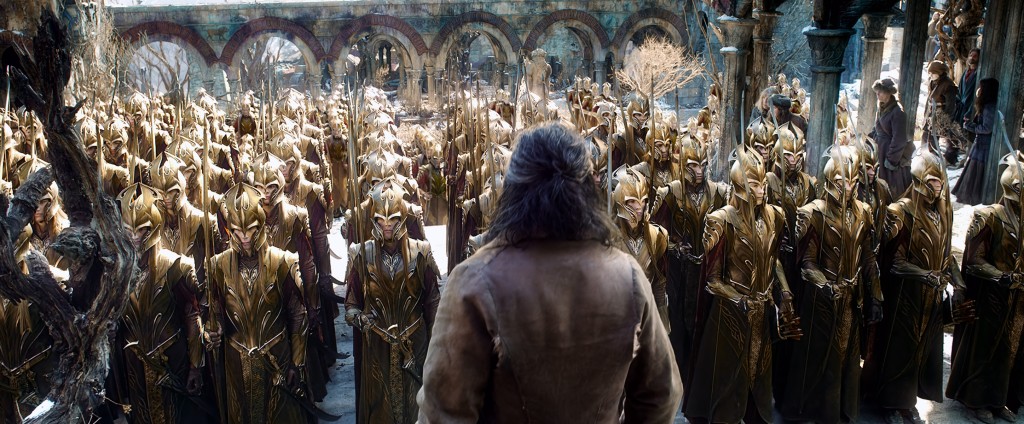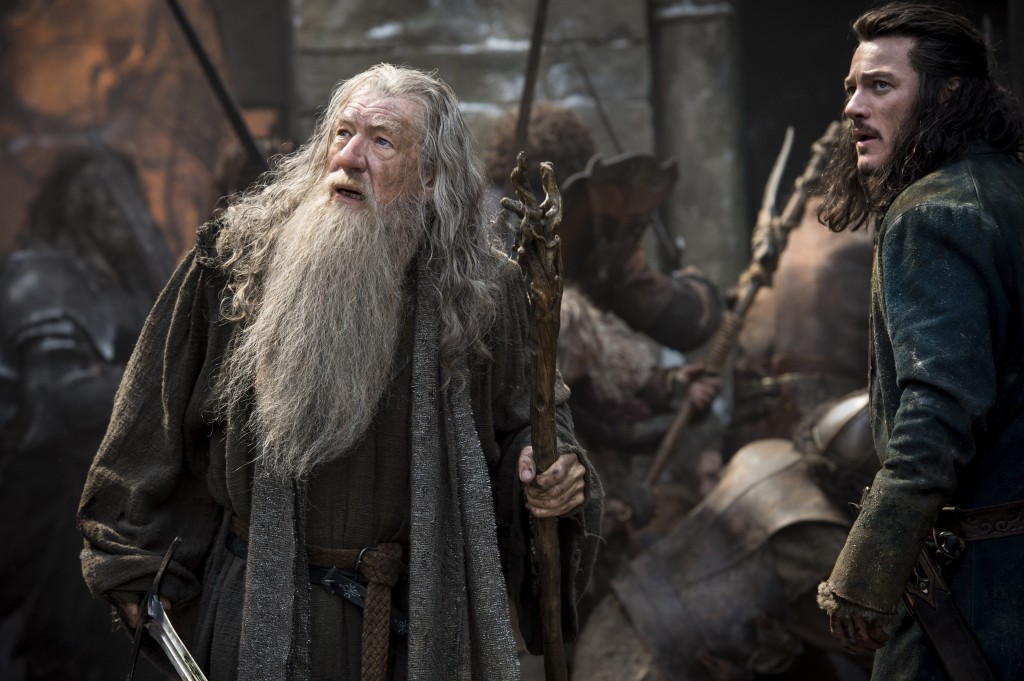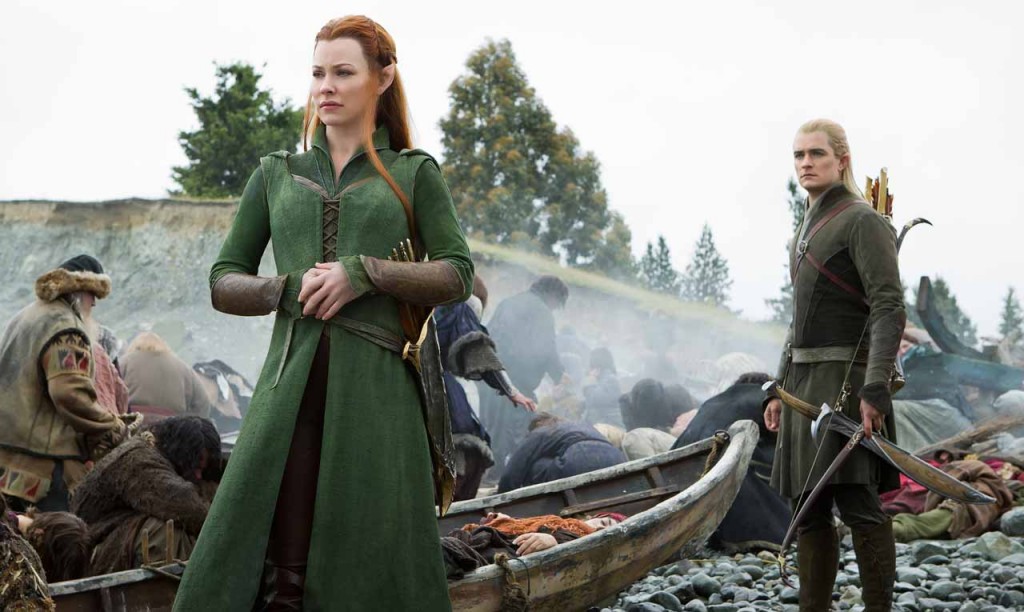The opening of the third and final installment of Peter Jackson’s Middle Earth prequel trilogy has to be one of the most bewildering experiences I’ve ever had in a movie theater. It picks up right where the prior film ended, with big-ass dragon Smaug (Benedict Cumberbatch) preparing to lay waste to Lake Town. The entire sequence, lasting something like ten minutes, ends exactly as you’d expect if you read The Hobbit back in middle school like the rest of us, except it all happens before the opening titles. For all intents and purposes, it’s the sword and sorcery equivalent of Bond killing Blofeld in the teaser of For Your Eyes Only, only really jarring. This is what The Desolation of Smaug should have ended with, right? Welcome to the unwieldy hot dog of footage that is The Hobbit: The Battle of the Five Armies.
Okay look. I like hot dogs. They’re great. But they are also, you know, hot dogs. Before I get too lost in this already shaky metaphor, I’ll put the fundamental problem with Five Armies at this: it’s too many different pieces from too many different places so that it doesn’t really jive together. Although punctuated by great moments and ideas, as a cohesive whole it leaves a weird taste.
(Spoilers below)
With Smaug dead at the hands of Luke “Furious 6” Evans’ Bard the Bowman, Bilbo Baggins (Martin Freeman) and his band of dwarf adventurers have seemingly accomplished the impossible task they set out to do; retaking their sovereign homeland Erebor beneath the Lonely Mountain. This plot line, and the complications it brings, are by far the strongest and most engaging of the film. The dwarves’ victory is a hollow one, as rightful king of the dwarves Thorin Oakenshield (masterful brooder Richard Armitage) succumbs to the lust for gold that destroyed his grandfather. Armitage’s unhinged, paranoid Thorin is truly menacing and his rapidly deteriorating kinship with his brothers in arms is (purposely, I think) troubling in much the same way as Frodo’s descent into addiction in the original Lord of the Rings. The first two Hobbit films spent a not insubstantial amount of time building an uneasy trust between Thorin and Bilbo. This one gleefully tears it apart.
When Thorin refuses to shelter the now displaced residents of Lake Town (Bard specifically accuses him of going back on his word, further proof that the noble dwarf lord isn’t in his right mind), it sets off a chain of events that bring together the titular five armies. Bard’s human refugees, plus a contingent of elves lead by David Bowie–Elf King Thranduil (Lee Pace, an actor who will wear all the make up Hollywood is willing to pay for), PLUS dwarven reinforcements lead by Thorin’s second cousin Dáin (a mostly CGI Billy Connolly riding an adorable pig), along with an approaching army of orcs, bats, and Dune-style sandworms. What’s interesting about this battle is that while it’s staged (maybe too much) like some of the earlier war sequences from Jackson’s Lord of the Rings films, the rationale behind it isn’t. At least initially, it strays from the kind of black and white morality that characterizes Tolkien’s source material. This isn’t a battle of noble intent or an assemblage of the forces of good committed to the doing the right thing; although Bard is driven by desperation and his duty as a leader, Thorin is motivated by madness, and Thranduil petty vanity in the form of a handful of elven gems. It’s a nice change of pace, and their inevitable putting aside of differences to battle Azog the Defiler and his hoards is out of necessity more than anything.
When the battle itself finally commences, it’s a pooling of this main plot line with a couple of other minor ones that feel like an afterthought at this point. Gandalf (Ian McKellan) is liberated from imprisonment by Special Guest Stars Galadriel (Cate Blanchett, who goes full on Dark Phoenix), Elrond (Hugo Weaving), and Saruman (heavy metal musician Christopher Lee). They chase off Sauron (Cumberbatch, again) and his Ringwraiths in a scene that looks cool but ultimately adds little to the overall story. Meanwhile Legolas (Orlando Bloom) and Tauriel (Evangeline Lilly) spend the better part of the movie feeling Conflicted and running around putting out various plot-induced fires. Tauriel was the out and out high point of Desolation of Smaug and, aside from one or two very specific moments, she feels wasted here. Legolas pretty much exists to do the D&D equivalent of extreme skateboard tricks while killing monsters and, you know what? I’m fine with that.
It’s really the last third or so of the movie’s big battle that really delivers beyond “cool looking stuff happening.” The deaths of Fili (Dean O’Gorman) and, later, Kili (Aidan Turner) are shocking and unromantic. Kili’s death especially adds a tragic dimension to his unfulfilled romance with Tauriel, an uneasy variant of one of the major dramatic conflicts of LOTR (the relationship between Aragorn and Arwen). Similarly, when Thorin and Azog kill each other in a cleverly choreographed duel over cracking ice, there’s a pronouncedly intimate vibe. Their multi-movie, hate-soaked bloodlust for each other only comes to an end after Thorin (atop Azog, their chests heaving) stabs the orc lord in the heart.
It was Peter Jackson’s original plan to split The Hobbit into two films. It’s easy to criticize that decision, but the truth is I don’t know how you’d reverse-engineer what ultimately became The Battle of the Five Armies back into parts one and two. As it is, the last trip audience’s will take to Middle Earth for the foreseeable future is an uneven but enjoyable one despite itself.
The Hobbit: The Battle of the Five Armies is in theaters nationwide today.





